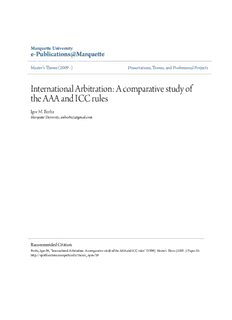
International Arbitration: A comparative study of the AAA and ICC rules PDF
Preview International Arbitration: A comparative study of the AAA and ICC rules
Marquette University e-Publications@Marquette Master's Theses (2009 -) Dissertations, Theses, and Professional Projects International Arbitration: A comparative study of the AAA and ICC rules Igor M. Borba Marquette University Recommended Citation Borba, Igor M., "International Arbitration: A comparative study of the AAA and ICC rules" (2009).Master's Theses (2009 -). 20. https://epublications.marquette.edu/theses_open/20 International Arbitration: A comparative study of the AAA and ICC rules by Igor M. Borba A Thesis submitted to the Faculty of the Graduate School, Marquette University, in Partial Fulfillment of the Requirements for the Degree of Master of Arts in International Affairs Milwaukee, WI December 2009 “Discourage litigation. Persuade your neighbors to compromise whenever you can. Point out to them how the nominal winner is often a real loser - in fees, expenses, and waste of time.” Abraham Lincoln ABSTRACT Arbitration has been used throughout history as an alternative dispute resolution method with great success. Today, arbitration is commonly used in international trade related disputes as one of the most common dispute resolution methods. In this thesis I will examine some of the most important international treaties and laws that regulate this dispute resolution method, such as the New York Convention, Uncitral Model Law, as well as the Federal Arbitration Act. The two most known international arbitration institutions are the main focus of this thesis. The international arbitration rules of the American Arbitration Association (AAA) and the International Chamber of Commerce (ICC) are analyzed, as well as a selection of cases of each one of these institutions. I offer some suggestions in order to make these rules even more effective; analyze how well each of these institutions reaches its goals, and provide a theoretical perspective regarding non-governmental organizations that deal with international arbitration. KEY WORDS: Dispute resolution. International arbitration. Arbitration courts. AAA. ICC. RESUMO Arbitragem como uma bem sucedida maneira alternativa de resolução de disputas ao longo da história. Atualmente, arbitragem é um dos métodos mais utilizados para resolver disputas relativas à comércio internacional. Nesta tese, alguns dos mais importantes tratados internacionais e leis que regulam esse método de resolução de disputas serão analizados, tais como a Convenção de Nova Iorque, Lei Modelo da Uncintral e o Ato Federal de Arbitragem. As duas mais importantes instituições de arbitragem são o focu principal desta tese. As regras de arbitragem internacional da Associação Americana de Arbitragem (AAA) e da Câmara Internacional de Comércio (CIC) serão analisadas, assim como uma seleção de casos de cada uma dessas instituições. Algumas sugestões serão oferecidas visando melhorar essas regras; uma análise de como cada uma dessas instituições atinge as suas metas será realizada, bem como será oferecida uma perspectiva teórica relativa à organizaçoes não governamentais que lidam com arbitragem internacional. PALAVRAS-CHAVE: Resolução de disputas. Arbitragem internacional. Cortes de arbitragem. AAA. ICC. i ACKNOWLEDGEMENTS Writing this thesis was a big challenge that required several months of hard work. In order to overcome this challenge the support of several people was essential and I would not have been able to finish this thesis without this precious help. First and foremost I would like to thank my parents for making all of this possible. Also essential was the help of my host parents Peggy and Tony, who have adopted me as their son since when we met when I was an exchange student in Milwaukee during high school. Thank you very much for editing this entire thesis for grammatical and spelling errors. The professors at Marquette University were also of extreme help, not only in this thesis, but in all my experience at Marquette. I would like to specially thank Professors Barrington, Schneider and LeBlanc for all their willingness to help. To all the others that also contributed for the conclusion of this thesis, my utmost thank you very much. ii TABLE OF CONTENTS ACKOWLEDGEMENTS………………………………………………………………………….i TABLE OF ACRONYMS………………………………………………………………………..vi INTRODUCTION………………………………………………………………………………...1 PART 1 ARBITRATION…………………………………………………………………………3 1.1 Definition……………………………………………………………………………………3 1.2 History and Evolution of Arbitration………………………………………………………..8 1.3 Major International Agreements and Regulation of Arbitration…………………………...12 1.3.1. NewYork Convention of 1958………………………………………………………13 1.3.2 United Nations Commission on International Trade Law (UNCITRAL)…………17 1.3.3 European Convention on International Commercial Arbitration of 1961…………22 1.3.4 Federal Arbitration Act…………………………………………………………….23 1.3.5 Other Treaties Relevant to International Arbitration………………………………24 1.4 International Relations Theories Relevant to Arbitration………………………………….26 1.4.1 Liberalism and Neoliberalism…………………………………………...…………....28 1.4.2 Functionalism and Neofunctionalism…………………………………………...……35 1.4.3: Rational Choice…………………………………………………………………...…37 1.5The Place of Arbitration Within the Globalized Economy of Today………………………38 1.5.1 Advantages of Arbitration Over Litigation…………………………………………..38 1.5.2 Data Regarding the Increase in the Use of Arbitration……………………………....40 1.5.3 Globalization and Regionalism……………………………………………………....42 1.6 Conclusion to Part I……………………………………………………………………...…..45 iii PART 2 AMERICAN ARBITRATION ASSOCIATION………………………………………46 2.1 American Arbitration Association – AAA………………………………………………...46 2.1.1 History………………………………………………………………………………..46 2.1.2 Goals of the AAA/ICDR……………………………………………………………..50 2.2 AAA Rules…………………………………………………………………………………52 2.2.1 Initiation of International Arbitration Procedure…………………………………….52 2.2.2 Arbitrators.…………………………………………………………………………...54 2.2.3 Place of the Arbitration…...………………………………………………………….57 2.2.4 Language of the Arbitration………………………………………………………….59 2.2.5 Hearings and Interim Measures……………………………………………………...60 2.2.6 Default Procedure…...……………………………………………………………….62 2.2.7 Award………………………………………………………………………………...62 2.2.8 Confidentiality……………………………………………………………………….64 2.3 AAA Case Study…………………………………………………………………………...65 2.3.1 Case Number 3419738…………………………………...…………………………..66 2.3.2 Case Number 833875……………………………...…………………………………68 2.3.3 Case Number 3250897……………………………………………………………….69 2.3.4 Other Cases and Further Aspects…………………………….………………………72 2.4 Conclusion…………………………………………………………………………………73 PART 3 INTERNATIONAL CHAMBER OF COMMERCE…………………………………..75 3.1 International Chamber of Commerce – ICC……………………………………………….75 3.1.1 History………………………………………………………………………………..75 iv 3.1.2 Goals…………………………………………………………………………………78 3.2 ICC Rules…………………………………………………………………………………..79 3.2.1 Beginning of International Arbitration Procedure………………………………...…80 3.2.2 Arbitrators……………………………………………………………………………82 3.2.3 Place of Proceedings…………………………………………………………………83 3.2.4 Procedure Rules and Language………………………………………………………84 3.2.5 Term of Reference………………………………………………………………...…86 3.2.6 Hearing...……………………………………………………………………………..87 3.2.7 Interim Measures…………………………………………………………………….89 3.2.8. Award and Further Procedure……………………………………………………….91 3.2.9 Correction of the Award and Costs………………………………………………..…94 3.3 ICC Case Studies………………………………………………………………………......96 3.3.1 Case Number 11.307…………………………………………………………………96 3.3.2 Case Number 13.278…………………………………………………………………99 3.3.3 Case Number 12.172………………………………………………………………..102 3.3.4 Other Cases…………………………………………………………………………103 3.4 Conclusion to Part III……………………………………………………………………..105 PART 04 – DISCUSSION OF FINDINGS AND CONCLUSION……………………………107 4.1 Goals achievement..………………………………………………………………………107 4.1.1 AAA ………………………………………………………………………………..107 4.1.2 ICC………………………………………………………………………………….109 4.2 Arbitration Rules………………………………………………………………………….111 v 4.2.1 AAA………………………………………………………………………………...111 4.2.2 ICC………………………………………………………………………………….115 4.2.3 Implementation of Changes…………………...……………………………………119 4.3Which Institution Is More Efficient and Why?....................................................................123 4.4 The Cases Analyzed and the Parties Involved……………………………………………127 4.5 International Arbitration Regulation…………………………..………………………….129 4.6 Conclusion………………………………………………………………………………..131 REFERENCES…………………………………………………………………………………135
Description: